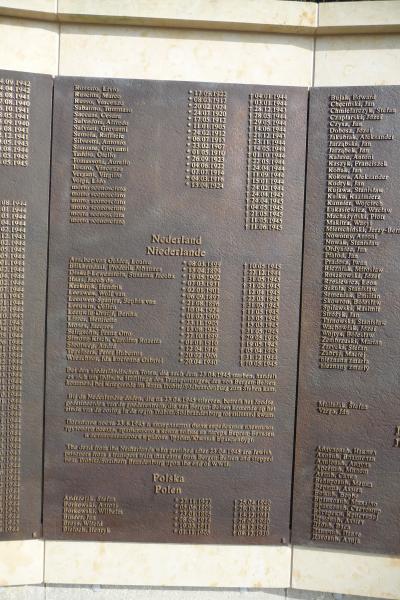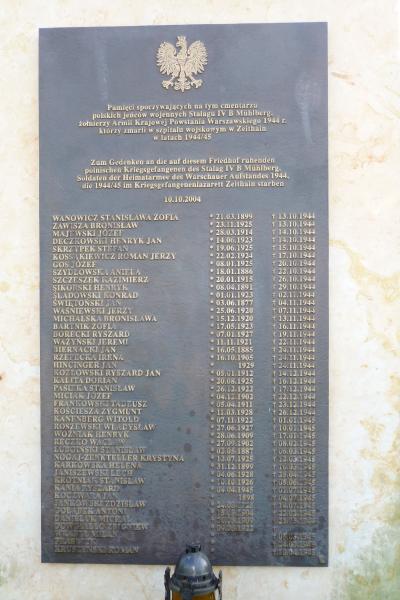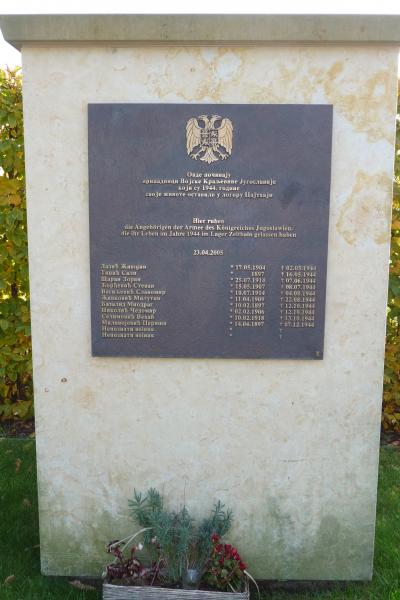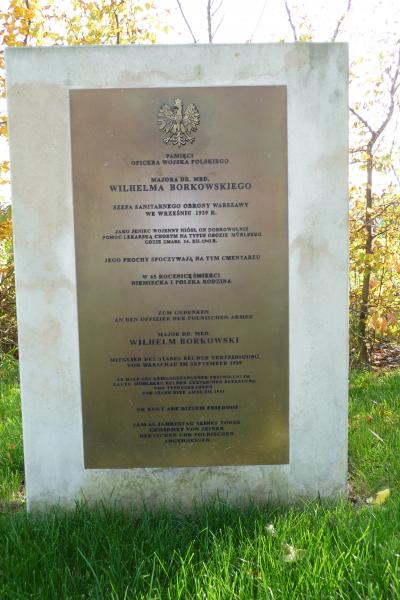Stalag IV B Mühlberg
The first interned in the stalag were Polish soldiers from the 1939 September Campaign. From autumn 1939 to spring 1945, a total of 53 Poles were buried at the cemetery, including 49 prisoners of war and 4 civilians who died in the first months after the war. In mid-October 1944, two railway transports arrived at the stalag with 1,400 wounded and sick Home Army soldiers and medical personnel from Warsaw insurgent hospitals. These people were placed in 25 empty wooden barracks where the Polish Military Hospital Zeithain was established. Thanks to the enormous commitment of doctors and nearly 400 nurses and auxiliary staff, the hospital shortly began to show an unprecedented level of hygiene and care as compared with other camp facilities of that type. Despite such good conditions, it was not possible to save the lives of 39 Home Army soldiers, among them three Slovaks, who died as a result of wounds and diseases acquired during fights. The soldiers were buried in individual graves at the camp cemetery for interned Italian soldiers in a separate Polish plot. The funerals were held with a ceremony and military honours and with the participation of the camp priest Albin Jakubczak.
650 individual graves became the burial places of prisoners of war from the countries of the western anti-Hitler coalition. The Russian occupation authorities, following Joseph Stalin's order No. 270 of the 16th of August 1941, recognising the Red Army soldiers who were taken prisoner as deserters and traitors of the homeland, exhumed all the Russians. They were buried again at the municipal cemetery in Elsterwerda as anonymous victims of German fascism. The ashes of prisoners of war from the USA, Denmark, France, Greece, the Netherlands and Great Britain were buried at war cemeteries in their homelands. The political authorities of the former GDR commemorated only the Russian victims of the Second World War here. Three cemeteries, including an Italian one with 44 individual graves of Polish men and women were located after the war in the territory of a Soviet Army military training ground. The cemeteries, which were inaccessible to visitors, families and close relatives of the buried soldiers, were completely devastated after years of intense military use. In 1991, the Italian army exhumed 863 deceased and transported their ashes to their homeland. Polish and Serbian graves were only located in May 2004. On the 30th of July, the ashes were moved to a common grave at the military cemetery in Neuburxdorf.
The necropolis is the burial place of 5 Belgians; the ashes of 3 people were probably transferred to Belgium by their families. 72 Italians were also buried there; the ashes of 7 Dutchmen were moved to one of the Dutch war cemeteries located in Germany. There are still 16 graves of Dutch Jews there, prisoners of the Belsen-Bergen concentration camp, who were liberated from a railway transport on the 23rd of April 1945. They died of exhaustion and disease during their imprisonment in the camp. 84 prisoners of war came from Yugoslavia, 2 from Slovenia, and an unknown number of them were Serbian citizens.
Below is a list of Home Army soldiers, participants of the Warsaw Uprising, who died in the Zeithain hospital:
Zawisza Bronisław, Rifleman, a.k.a. "Wiktor"
* 23.11.1925 Warsaw
† 13.10.1944
Wanowicz Stanisława Zofia
* 27.4.1899 Warsaw
† 13.10.1944
Majewski Józef, Lance Corporal Rifles
* 28.8.1914 Żabice district Łuck
† 14.10.1944
Deczkowski Henryk Jan, Cadet Officer, a.k.a. "Wierusz"
* 14.6.1923 Warsaw
† 14.10.1944
Skrzypek Stefan, Corporal, a.k.a. "Pepi"
* 19.6.1925 Warsaw
† 15.10.1944
Kossakiewicz Roman Jerzy, Corporal, Cadet Officer, a.k.a. "Kos"
* 22.2.1924 Warsaw
† 17.10.1944
Gos Józef, Rifleman
* 8.1.1925 district Rawa
† 20.10.1944
Szydłowska Aniela
* 18.1.1889 Pułtusk
† 22.10.1944
Szczeszek Kazimierz, Sergeant, Cadet Officer, a.k.a. "Adam"
* 20.1.1915 Warsaw
† 26.10.1944
Sikorski Henryk, Major, a.k.a. "Goplański"
* 8.4.1891 Ornikowo
† 29.10.1944
Śladkowski / Śladowski Konrad, Corporal
* 1.1.1923 Gródek district Sokołów Podlaski
† 2.11.1944
Świętoński Jan
* 3.6.1877 Siedlce
† 4.11.1944
Waśniewski Jerzy, Lance Corporal Rifles
* 25.6.1920 Warsaw
† 7.11.1944
Michalska Bronisława, Runner, a.k.a. "Broszka"
* 15.7.1920 Kijów
† 13.11.1944
Bartnik Zofia, Runner
* 17.05.1923 Rykały district Grójec
† 16.11.1944
Borecki Ryszard, Lance Corporal Rifles, a.k.a. "Sęp"
* 2.1.1927 Warsaw
† 19.11.1944
Ważyński Ireneusz, Corporal, Cadet Officer, a.k.a. "Jeremi"
* 11.11.1921 Vilnius
† 22.11.1944
Biernacki Jan, Lieutenant
* 16.5.1886 Warsaw
† 24.11.1944
Hincinger-Dziubiński Jan, Rifleman
* 7.6.1929 Równe
† 24.11.1944
Rzepecka Irena
* 16.10.1905 Warsaw
† 26.11.1944
Kozłowski Ryszard Jan, Sergeant
* 5.1.1912 Wola Lipienicka near Radom
† 14.12.1944
Kalita Dorian, Rifleman, a.k.a. "Dodek"
* 25.8.1925 Grodno
† 16.12.1944
Pasieka Stanisław, Sergeant
* 26.12.1922 Wola Blizocka near Łuków
† 17.12.1944
Maciak Józef, Corporal
* 4.12.1902 Pechenizhyn near Kolomyia
† 22.12.1944
Frankowski Tadeusz, Rifleman
* 5.9.1911 Pargi
† 23.12.1944
Kościesza Zygmunt, Rifleman
* 11.3.1928 Warsaw/Piastów
† 26.12.1944
Kanenberg Witold Karol, Lance Corporal Rifles
* 7.11.1922 Pabianice
† 1.1.1945
Roszewski Władysław, Corporal, a.k.a. "Hindus", "Tom"
* 27.6.1927 Warsaw
† 10.1.1945
Woźniak Henryk, Sergeant, a.k.a. "Heniek"
* 28.6.1909 Warsaw
† 17.1.1945
Reczko Wacław, Sergeant
* 27.9.1902 Częstocice near Kielce
† 8.2.1945
Luboiński Stanisław, Rifleman
* 2.5.1987 Warsaw
† 6.3.1945
Wrobel Milan Slovak, 353 "Slovaks" Platoon
† 5.3.1945
Nogaj Krystyna, Riflewoman, Runner/Nurse
* 12.8.1925 Poznań
† 12.3.1945



